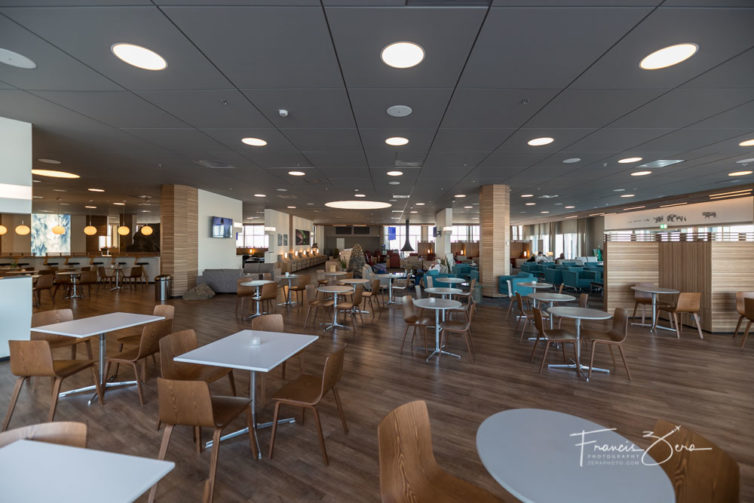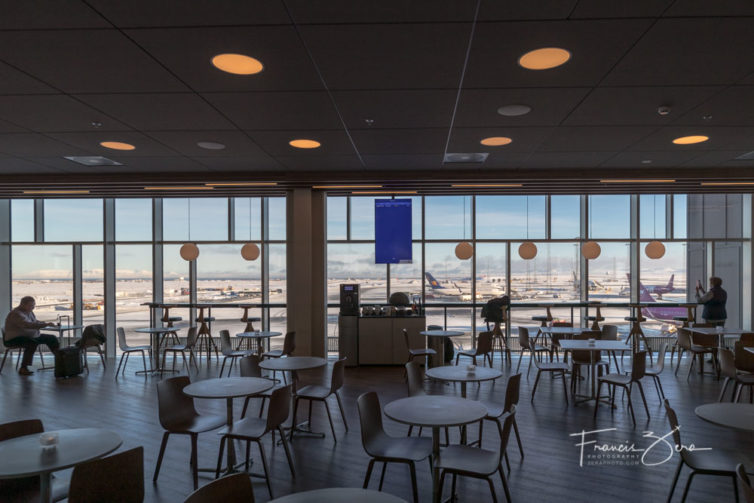
The backstory
Loyal readers will recall our 2017 review of Saga Premium (which, at the the time, was called Saga Class) on Icelandair’s venerable 757-200s.
Since then, Icelandair has added several Boeing 737 MAX 8 jets to their fleet (they ordered a total of 16 of the MAX in both the -8 and -9 variants), using them on routes to U.S. destinations on the east coast and upper midwest, along with several European routes.
I flew SEA-KEF on a 757, then returned via Chicago on a 737 MAX 8, as Seattle is, unfortunately, beyond the working range of the MAX 8.
So, two years on, what was it like to fly Saga? Candidly, I was a fan of the last trip, so the memory still felt fairly fresh. My outbound flight was on TF-FIR, aka Vatnajà¶kull, aka 80 years of Aviation, aka the glacier livery.
This AvGeek was stoked at the opportunity to fly on Vatnajà¶kull, even though it was parked at a corner gate between two diagonal jetways at SEA, making photos pretty much impossible that day. IMHO, it’s the one of prettiest planes in the sky today, tied for that honor with Icelandair’s Hekla Aurora livery on TF-FIU.

TF-FIR landing at Seattle-Tacoma International Airport in 2017. I wasn’t able to get out on the ramp to get pre-flight photos for this trip, so we’ll have to make do with an existing image
The outbound flight from SEA to KEF was as good as the last time – I was in seat 1A for this flight, which is in a bulkhead row. The seats themselves are the same as we reviewed in 2017. They feel even more dated now, especially when compared to contemporary options even on some domestic US carriers, but they’re still very comfortable and offer a generous amount of recline.

Flying over the Canadian Rockies in TF-FIR
I love the 757. But it’s an old design and the aircraft are nearing the end of their service lives. While the MAX lineup isn’t a replacement for the 757 (nor, really, is the A321n, but that’s a different discussion for another time), it works for certain transcontinental-length flights, but doesn’t have quite the range to fully replace it.
The main event Saga Premium from KEF-ORD on the MAX 8
After an awesome couple of days exploring Reykjavik, spending a day at Icelandair’s MidAtlantic travel trade show, having lunch with Icelandair’s CEO Bogi Nils Bogason and CCO Gunnar Már Sigurfinnsson, and scoring a helicopter tour from Nordurflug Helicopters (more on those in separate upcoming stories), it was time to say bless à bili to Iceland and head home.

Love those split-scimitar winglets
Let’s start in the lounge
Icelandair’s Saga Lounge at KEF has been open for a while now, but it was my first visit.

Velkominn to the new lounge
The lounge is spacious, bright, and comfortable in a very Scandinavian-style way. While some might find it a bit austere, I quite like the clean lines and the fact that there are plenty of tables available. Some lounges I’ve recently visited are so heavy on the recliners and sofas that there is practically no work space, or even a proper place to eat without feeling like you are juggling plates at a cocktail party. There are still lots of lounger-style seating, all with plenty of power ports. This place is a win for me.

The Saga Lounge at KEF – Eurostyle FTW
My only complaint is that the airport consistently uses metal screens between the panes of exterior glass. It’s most likely there to reduce thermal gain in the warmer months, but it makes for lousy photos out the windows.

Boo those window screens ruin the fun for photos
The use of such screens isn’t unique to Icelandair’s lounge, though they’re on nearly every window in the airport I’m guessing it’s an airport design requirement.

The buffet area

Lots of cushy seats
The lounge has window walls that look out over airport ramps and hardstands and the expansive Icelandic landscape beyond. It’s a lovely place to pass the time before a flight.

And, of course, there are expansive views of the ramps to keep the AvGeeks happy
For the seven-hour KEF-ORD flight, I was in seat 1F, also a bulkhead row. I chose the seats deliberately so I could compare relative legroom across the two aircraft types. Even though the MAX 8 is a smaller aircraft, interior space utilization is worlds better than on the aging 757, with a corresponding moderate increase in legroom.

Boarding time – hardstand boardings are awesome because you get to see the plane up close
It was the usual KEF scrum to board – there was a quiet boarding call only at the immediate gate area, then we all lined up to board a bus to the hardstand. A short drive later, we were at the plane and walking across the slushy ramp to the airstairs.

Icelandair’s MAX 8 seat map – there are 144 standard seats and 16 in Saga Premium. Image: Icelandair
We were welcomed on board and had plenty of time to settle in, as, for whatever reason, we departed about 20 minutes late. But I didn’t care, as I had a window seat, a great view of the nearby ramps, and plenty of time for my connecting flight on the other end.

The MAX 8 seats are similar to the 757 variety, but felt more comfortable and a bit more roomy
The overhead bins on the MAX 8 are absolutely cavernous, especially compared to those on the 757s. The camera backpack I use for trips like this is technically small enough to fit under the seat, but it still was a bit of a squeeze in the 757 overhead bins.
It looked forlorn in the huge MAX 8 bins, and actually drifted around a bit during the flight as the bins were nowhere close to being filled. If you’ve flown on a 737NG with the Boeing Sky Interior, you’ve seen these bins. They’re awesome.

It’s always comforting to watch your bag being loaded onto the same plane you’re flying in
At takeoff, the MAX 8 was as quiet as I was told to expect. Being up front never hurts, but this was perceptually as quiet as I remember my last 787-9 flight having been. I’ve got a relatively-accurate decibel-meter app on my phone, and it measured 84db on full-throttle takeoff. I’ve recorded 100db up front on older 737s during takeoff, and keep in mind that the db scale is logarithmic, so each incremental change represents quite large sound-pressure differences.

In the first row in Saga, your IFE screen is on the bulkhead, and the USB charger port and headphone port are both on the bottom edge of the frame. Easy to get to, but be sure to bring your long phone cable. I had a six-foot cable that worked out perfectly. The coathook is a nice touch, especially when you’re dressed for Icelandic weather
While equipped with the widely-anticipated Viasat WiFi , Icelandair’s systems are still awaiting certification, so the fast satellite service will have to wait until a future review. Airline officials said they anticipate receiving that certification this spring.

The meal was delicious. I quite enjoyed the licorice-infused smoked salmon appetizer. The chicken wasn’t dry, and the vegetables weren’t overcooked; high praise for airline food, which has a zillion preparation, delivery, and consumption constraints. That mess, BTW, was all me – I managed to stick my hand in the sauce when reaching for the cloth napkin.
I didn’t use the IFE system for much other than tracking our progress, but I did note a reasonably wide selection of stuff to watch. The screen size and resolution are good, and I did enjoy the selection of Icelandic music.
Remaining observations: the forward lavatory is tiny. As in, I couldn’t stand up straight in there. But that’s the new standard for these planes as airlines work to maximize space utilization, and how much time does one really spend in a lav on a flight of this length anyway?
It still had that new-airplane smell. And, underneath that, it smelled vaguely of tuna-noodle casserole, although that wasn’t on the menu. Weird.
Conclusion
In researching for this article, I read quite a few reviews about other airlines’ MAX 8s. It seems Icelandair has taken a middle-of-the-road approach, and succeeded pretty well. The routes from KEF to the US East Coast and Upper Midwest basically mirror transcontinental routes in duration, so there’s not a huge need for the amenities expected on true long-haul flights. But I do wish the bathrooms weren’t quite so tiny.
Icelandair’s MAX 8 Saga Premium is a solid product – relatively spacious, comfortable, with good food and good service. It doesn’t pretend to be anything other than exactly what it is, which is both refreshing and very Icelandic.
Disclosure: Icelandair invited AirlineReporter on board at its expense for the round-trip flights; our opinions remain our own.
Looks like they need more loading bridges at Reykjavik, re passenger comfort in wintry weather : )
Thanks for commenting, David. Based on a conversation I had with a KEF airport official, they are planning to expand the terminal over the next several years, adding more gates with jetbridges.
Hello, flying from Mpls to Iceland this coming Saturday. Considering asking for transport assistance due to double hip replacement last Sept/Nov. How does the airline accommodate with all the stairs? We are flying Premium Saga. This will help give me a little more comfort, being able to stretch and change seat position.
Also, are Premium saga guests aloud access to the Saga lounge? Or is that privilege granted to miles earned guests?